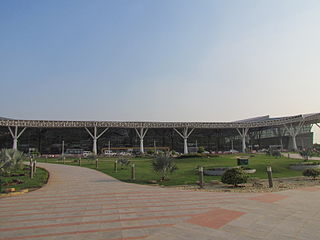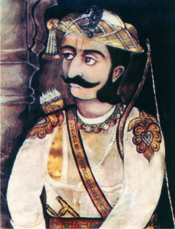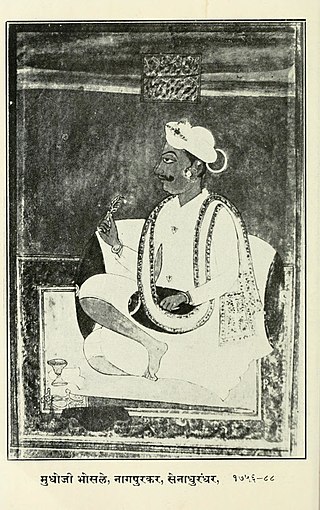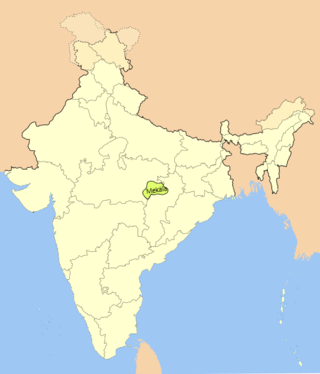
Raipur district is a district in the Chhattisgarh state of India. Its administrative headquarters is the city of Raipur. The district is rich in mineral resources and there are many wildlife sanctuaries. With a population of 2 million, it is the most populous district of Chhattisgarh.

Rajnandgaon is a district of the state of Chhattisgarh in central India. The administrative headquarters the district is Rajnandgaon town.

Nagpur Province was a province of British India that covered parts of the present-day states of Madhya Pradesh, Maharashtra, and Chhattisgarh. The city of Nagpur was the capital of the province.

Durg is a city in the Indian state of Chhattisgarh, east of the Shivnath River and is part of the Durg-Bhilai urban agglomeration. With an urban population of 1,064,077, Durg-Bhilai is the second largest urban area in Chhattisgarh after Raipur. It is the headquarters of Durg District.

Ratanpur is a town and a nagar palika in Bilaspur district in the Indian state of Chhattisgarh. It is located about 25 kilometres (16 mi) from Bilaspur on National Highway 130 towards Ambikapur.

The Kingdom of Nagpur was an Indian kingdom in the 18th and 19th centuries. It came under the rule of the Marathas of the Bhonsle dynasty in the mid-18th century and became part of the Maratha Confederacy. The city of Nagpur was the capital of the state.

Chhattisgarh Division was an administrative division of the Central Provinces of British India. It was located in the east of the Central Provinces and encompassed the upper Mahanadi River basin, in the central part of present-day Chhattisgarh state of India.

Raghoji I or Raghuji the Great, was a Maratha general of the Bhonsale dynasty who established the Nagpur Kingdom in much of east-central India during the reign of Chhatrapati Shahu I. His successors ruled the kingdom until 1853.

Kanker State was one of the princely states of India during the period of the British Raj. Its last ruler signed the accession to the Indian Union in 1947.

Mudhoji I was the ruler of the Nagpur kingdom from 1772 to 1788. During his regency the kingdom remained peaceful and prospered.

The Kalachuris of Ratnapura were a central Indian dynasty during 11th and 12th centuries. They ruled parts of present-day Chhattisgarh from their capital at Ratnapura. They were an offshoot of the Kalachuris of Tripuri, and ruled as vassals of the parent dynasty for many years.
The Garha Kingdom, also called Garha Mandla or Garha Katanga, was an early-modern-era kingdom in India. It was the first large kingdom to be founded by the Gond tribe and dominated much of Central India at its peak.

The Bhonsles of Nagpur were a Maratha royal house that ruled the Kingdom of Nagpur from 1739-1853. They hailed from the Bhonsle clan of Marathas and were one of the most important and powerful Maratha chiefs in the Maratha Empire.

The Gonds of Deogarh were a Gond royal house that originally ruled the zone which became the Nagpur Kingdom after being practically being made state pensionaries by the Bhonsle Maratha leader Raghoji I Bhonsle. They made Nagpur region a prosperous and plentiful kingdom, founding the city of Nagpur and building further infrastructure. However, internal bickering led to their downfall.
Bhaskar Ram Kolhatkar, known as Baba Bhaskar Pandit by the people of Bengal, was a Maratha general and statesman. He was the dewan of the raja of Nagpur, Raghuji Bhonsle. He played an important role in the kingdom of Nagpur's expansion. The first Maratha invasion of Bengal in 1741, as also the third in 1744, was led by him. He was an able military leader, proven by his success in the Maratha invasions of Bengal and conquest of Chhattisgarh. He was killed by Alivardi Khan on 30 March 1744.
The siege of Ratanpur in 1740 was a siege laid by the Marathas of Nagpur on the fort of Ratanpur, capital of the Haihaiyavanshi Kingdom. There was almost no resistance by the Haihaiyavanshis, which resulted in a Maratha victory.

Bimbaji Bhonsle was the youngest son of Raghoji I Bhonsle, the Maratha ruler of Nagpur. Bimbaji was the ruler of Chhattisgarh on behalf of the Raja of Nagpur. However, he was only nominally subordinate to the Raja of Nagpur, as he had a separate army and court with ministers at his capital of Ratanpur.
Mohan Singh was the last ruler of the Haihaiyavanshi Kingdom, the dynasty which ruled Chhattisgarh for over 700 years. He ruled Chhattisgarh under the suzerainty of the Bhonsles of Nagpur Kingdom.

Mekala is a historical region of India, extending from Amarkantak to Balaghat. It corresponds to the Maikal Hills, which comprises the present-day Kawardha District of Chhattisgarh state and Anuppur district of Madhya Pradesh. In the medieval period, the region was ruled by the Panduvamshis of Mekala.
Babu Revaram was a prominent poet and historian of Chhattisgarh, who played a vital role in reconstructing the history of that region. He is known as the "first historian of Chhattisgarh" because he wrote several important historical works such as the Tawarikh Shri Haihaiyavamsa Rajaon ki and Ratanpur Itihas. He also wrote poetic works like Saar Ramayana Deepika and Geeta Madhav. The term "Chhattisgarh" was first used in a historical text by Babu Revaram in his Vikram Vilas, published in 1839.














